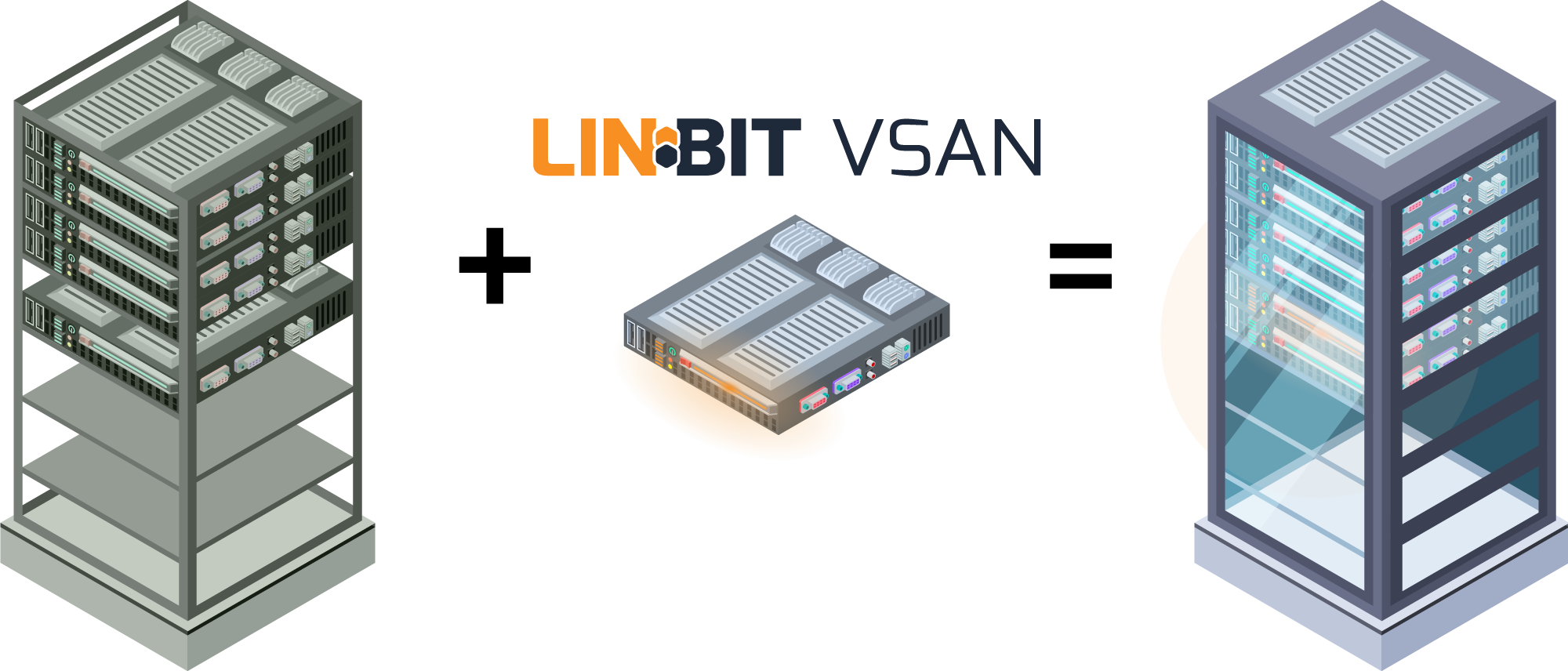Hyperconverged infrastructure (HCI) is a computer systems architecture that abstracts the compute, storage, and networking components of the architecture by using their software-defined functional equivalents and is run from a single system, rather than across multiple systems. The LINBIT® software-defined storage (SDS) solution is often used in HCI to provide, as you might guess, the storage component of an HCI.
Hyperconvergence Compared To Disaggregation
In HCI, rather than running the infrastructure components on a dedicated hardware appliance from a vendor, as one might do in a disaggregated architecture, the infrastructure components are software-defined (or virtualized) and hosted on a hypervisor. HCI allows software-defined components and the applications and services on top of them to run on commercial off-the-shelf (COTS) hardware. This usually has the benefit of reducing hardware costs while avoiding hardware vendor lock-ins1.
Another benefit that HCI can provide when compared to disaggregated infrastructure is that HCI will usually make the management of the entire system simpler. The software-defined nature of the HCI system abstracts away many of the complexities of managing the respective system component, whether it is storage, networking, or compute.
What all of that means practically is that HCI allows systems administration and development teams to focus more on applications and services rather than hardware and systems management.
To use an idiom, the software-defined solution takes care of the heavy lifting of managing a system. As a result, the systems administrator is usually tasked with simply customizing the system to the requirements of applications and services, and keeping tabs on system health using various monitoring solutions. Often monitoring solutions are (or should be) integrated with the software-defined solutions. This makes monitoring system health and configuring alerts even simpler for the systems administrator. For example, the LINBIT SDS solution can integrate with the widely-used Prometheus and Grafana monitoring and alerting tools.
Hyperconvergence Benefits
Besides the already mentioned general benefits of reducing hardware costs and the complexities of systems management while avoiding hardware vendor lock-ins, some of the potential benefits of HCI are summarized below.
Easy Deployment
One of the main reasons that organizations and businesses turn to HCI is the simple deployment process. This includes both the procurement of the system, because you can use COTS hardware, as well as the virtualization of workloads.
The software-defined aspect of HCI reduces the work hours necessary to research different hardware, their setup, and their compatibility. Software defined capabilities also simplify allocating resources and workload deployments through automation.
Easy Management
An IT department will have a much easier time managing and monitoring HCI systems than it would a system that is a collection of disparate hardware and environments. With a virtualized HCI environment, the software runs the environment and carries out all the everyday operations, such as resource provisioning and load balancing. System administrators use a management platform that unites all administrative tasks.
As a result, HCI eliminates the management silos that inevitably come with separate management platforms. System administrators can also choose to back up and restore virtual machines (VMs) or manage the entire setup from a distance.
Your IT team will have more time on its hands. Team members can then invest more time into assignments that directly relate to revenue, such as focusing on delivering improved applications and services to customers.
Simple Upgrades
Compared to conventional infrastructure, an HCI platform offers a single ecosystem that makes software and hardware upgrades much faster and easier.
Without the complexity and characteristics such as vendor lock-in that are associated with disaggregated solutions, software-defined infrastructure offers a scalable and adaptable environment for restructuring systems or incorporating hardware.
HCI also provides a single interface that uses standard protocols and integrated technologies, making performance metrics and enhancements more familiar to operations teams, which means they are easier to implement.
Scalability
Scalability is a critical factor for many organizations when selecting an HCI platform.
An HCI cluster is made up of nodes, which are self-contained, preconfigured building blocks that can be included or excluded as needed.
When deploying an HCI solution, the IT team can start small and scale up as required. The traditional alternative is to spend upfront on infrastructure that might not be used.
System administrators can also connect nodes without worrying about integration problems because the software-defined aspects of HCI should abstract the hardware.
Reliability
An HCI platform’s multinode architecture ensures a highly stable and usable system.
The HCI cluster contains several nodes that distribute functions throughout the cluster to provide resiliency and high availability.
An HCI platform has fault tolerance and disaster recovery built-in, so if one node fails, services and applications will fail over to another node in the cluster.
Better Workload Performance
Even while running multiple application types, an HCI platform provides capabilities that can help boost workload performance.
For example, both solid-state drives and slower, spinning hard disk drives can be used in an HCI framework. This allows HCI to flexibly meet the various performance demands of different workloads, such as databases or virtual desktop infrastructure. More importantly, since the storage and compute resources are physically located on the same node, latency and throughput between the two are not affected by the limitations of a network fabric.
Integration in the Cloud
Hyperconvergence is based on an architecture that gives its user experience a cloud-like feel.
An HCI framework, similar to a cloud computing service, abstracts the underlying hardware resources and presents them to the system administrator as consumable services or objects. This streamlines and simplifies administrative operations. Resources, like storage, that are consumed by various platforms, applications, or services, can be implemented and managed more effectively by administrators, just like in a cloud environment.
Conclusion
After itemizing the advantages of hyperconvergence, the benefits share two characteristics. Each benefit will either lower costs or increase productivity.
HCI makes sure that hardware resources are used as efficiently as possible, while human capital is directed towards more productive activities. The COTS setup allows you to forego the need for an expensive initial investment in hardware, and the software-defined abstractions of resources simplifies administrating the system. This also applies to upgrades, as well as any form of scale-up activity.
If you are interested in implementing HCI for your needs, request a demo of LINBIT VSAN today and see the benefits firsthand.
1. Astute or legally-minded readers might notice the opportunity that this sentence provides for an organization using HCI to avoid hardware vendor lock-in while potentially exposing itself to software vendor lock-in. In some cases, depending on the HCI solution, it just might mean that you trade one type of lock-in for another. Not the LINBIT solution, however. One of LINBIT’s core values is allowing you the freedom to shape your destiny. Yes, LINBIT is a company and sets out to make money, however, LINBIT’s software-defined solutions are open source and never hold your data hostage. You control your data and can migrate or recover it at any time using common tools, independently of LINBIT software.


